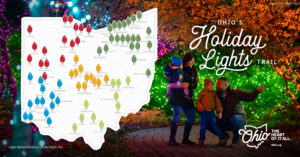Rainbow Trout Releases to Begin Across Ohio Starting on March 6

 COLUMBUS, OH – Ohio’s annual release of rainbow trout begins Friday, March 6, at Adams Lake in Adams County, according to the Ohio Department of Natural Resources (ODNR). More than 98,000 rainbow trout will be released into 63 public lakes and ponds on selected dates through May.
COLUMBUS, OH – Ohio’s annual release of rainbow trout begins Friday, March 6, at Adams Lake in Adams County, according to the Ohio Department of Natural Resources (ODNR). More than 98,000 rainbow trout will be released into 63 public lakes and ponds on selected dates through May.
Several locations will hold special angler events during the scheduled releases, including youth only fishing. Contact the nearest wildlife district office for specific times and locations. More information about trout releases can be found at wildohio.gov or by calling 800-WILDLIFE (945-3543).
Rainbow trout are a cold water species that do not naturally reproduce in Ohio waters, and these releases provide fantastic opportunities for anglers to pursue a fish they may not otherwise have the opportunity to catch. The trout are raised at state fish hatcheries and released at suitable locations to provide additional opportunities for anglers. They measure 10-13 inches before they are released by the ODNR Division of Wildlife. The daily catch limit for inland lakes is five trout.
Anglers age 16 and older must have a current Ohio fishing license to fish in state public waters. The 2015-2016 fishing license can be purchased online at wildohio.gov or at participating retail outlets. A full list of retailers is provided online.
Resident fishing license cost $19 and are valid from March 1 until Feb. 29, 2016. Ohio residents born on or after Jan. 1, 1938, and have resided in Ohio for the past six months are eligible to purchase a reduced-cost resident senior license for $10.
Sales of fishing licenses along with the Sport Fish Restoration (SFR) program continue to fund the operation of the ODNR Division of Wildlife’s fish hatcheries. No state tax dollars are used for this activity. This is a user-pay, user-benefit program.
The SFR is a partnership between federal and state government, industry, and anglers and boaters. When anglers purchase rods, reels, fishing tackle, fish finders and motor boat fuel, they pay an excise tax. The federal government collects these taxes, and the U. S. Fish and Wildlife Service administers and disburses these funds to state fish and wildlife agencies. These funds are used to acquire habitat, produce and stock fish, conduct research and surveys, provide aquatic education to youth, and secure and develop boat accesses.








